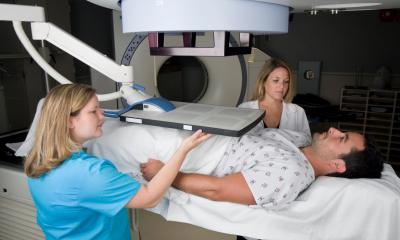Molecular medicine
A weapon to beat high-risk plaque
It has only recently been discovered that very often it is not the size of the plaque in the coronary vessels but its inflammation status that determines the occurrence of a cardiac infarction.

In molecular medicine, the High-Risk Plaque Initiative is one of the most important projects of Philips Medizin Systeme, as Paul Smit, in charge of strategy and development in the Dutch company, explained: ‘Today, high-risk plaque is recognised as the major cause of cardiac infarction which kills about 50 percent of the patients. This means, in many cases, death is the first symptom of the disease. Furthermore, those patients who survive the event are chronically ill and require medical care for the rest of their lives. This disease is not only dangerous for the patients but also presents an immense financial burden on the healthcare system – a burden that will increase steadily over the next few years. In short, high-risk plaque is one of the most fatal and one of the most expensive diseases.’
In addition, coronary plaque is a highly unpredictable condition because, depending on the degree of inflammation, the plaque suddenly ruptures and causes an embolism, which in turn leads to a cardiac infarction, or a stroke. This sudden rupture of inflamed plaque in a coronary artery explains why 70–75% of cardiac infarctions occur without prior symptoms.
‘Hitherto physicians were unable to determine when the plaque has reached a dangerous stage. Today, molecular medicine offers the possibility to identify indicators of the inflammation. The first task of the High-Risk Plaque Initiative is to develop a broad patient screening concept, which we hope will show early indicators in patients with infarcts that are not present in the control group. If we know these early indicators, or biomarkers, which predict an inflammation, thanks to modern imaging methods we will be able to locate the high-risk plaque and determine its volume,’ Paul Smit pointed out.
The collected data can be combined with statistical values and thus provide valuable information on the patient’s current and future risk. Currently, Philips and the other members of the High-Risk Plaque Initiative are developing a test that will be applied to more than 6,000 patients in coming years.
Early diagnosis of high-risk plaque is no doubt a major step forward. However, it has to lead to targeted therapies for the affected coronary vessels. Today, physicians are rather powerless when it comes to the treatment of plaque, since there are no validated tests to determine the effectiveness of drugs. However, it appears to be proven that regular monitoring and a healthy lifestyle often improve a patient’s condition.
Molecular medicine offers promising approaches for other diseases as well - cancer, for example. Currently, methods are being researched that use ultrasound to transport medication through the vessels right to the affected body region. The medication is docked onto micro-bubbles, or a contrast agent, and injected in to the body. With the help of ultrasound signals the physician can trace the bubbles’ route to the target region. As soon as the bubbles reach the affected tissue a certain ultrasound frequency causes them to burst and the active agent is released. Because the medication is administered in a very targeted way, a much lower dose than in a systemic therapy is required – which increases the therapeutic success and significantly reduces side effects. The principle has already been tested in pre-clinical trials and is now being developed for clinical use in a joint effort with the pharmaceutical industry. The Philips research team has already gone one step further and is working on finding out whether this innovative method can be used for cardiac diseases.
‘We are still in the early stage of research into validated biomarkers and it will take about four more years before we will be able to identify high-risk plaque with the help of biomarkers. However,’ Paul Smit concluded optimistically, ‘these developments will open entirely new possibilities from which both the patients and the healthcare system will profit: Early diagnosis can significantly reduce treatment and follow-up costs of many diseases.’
Report: Meike Lerner
01.09.2007











